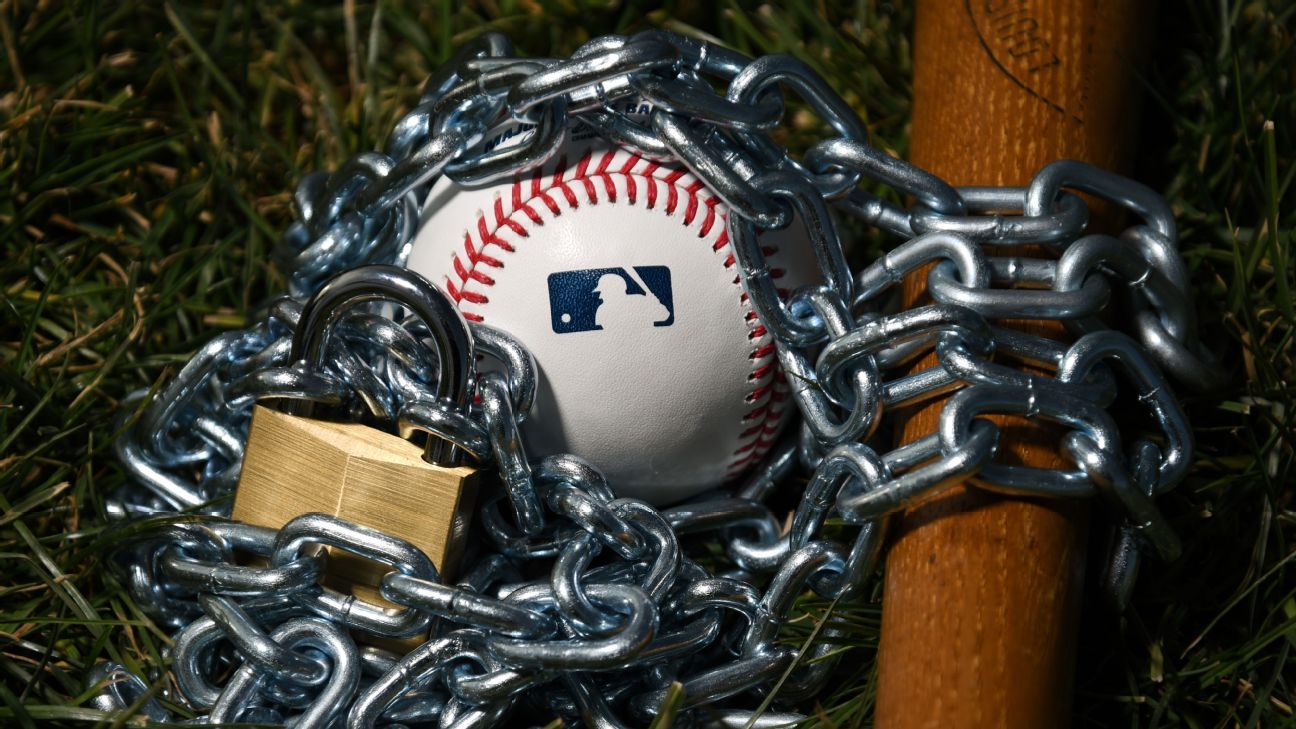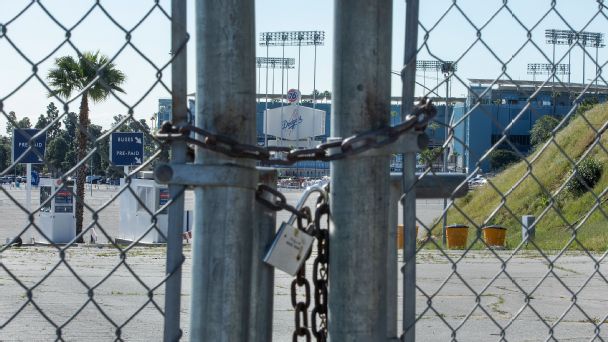
Almost two months after the MLB lockout began on Dec. 2, it seems like very little progress has been made toward a new collective bargaining agreement. So what exactly is going on between the owners and players during baseball’s work stoppage? Are the two sides moving any closer to a deal? And most importantly: When is it time to worry about the start of spring training and even the 2022 MLB regular season?
ESPN baseball experts Jeff Passan and Jesse Rogers tackle those questions and more.
Latest: Sources: MLB makes first labor proposal since lockout | Why MLB’s labor negotiations have gone nowhere — and baseball’s path back
More: Lockout FAQ | A brief history of MLB labor stoppages (ESPN+) | ‘Oh, my God — how can we do this?’: An oral history of the 1994 MLB strike
When did the two sides meet last?
The long-awaited first meeting since Major League Baseball locked the players out happened Jan. 13 over Zoom. After 43 days of inaction by the sides, the league presented an offer that included paying players with between two and three years service via a formula, rewarding teams that bring up top prospects with extra draft picks and a slight tweak to its proposed draft lottery. The players found none of the league’s ideas particularly compelling.
When are they planning to meet again?
They will meet face to face — for the first time since Dec. 1 — on Monday, when the MLB Players Association is expected to counter the league’s proposal.
2 Related
What’s expected to be covered in the next meeting?
The thrust of the union’s proposal is unclear. From the beginning of negotiations nearly a year ago now, the players have pushed for a suite of changes to the previous CBA. Among their desires: earlier free agency and arbitration, disincentivizing tanking, a significant increase in the competitive balance tax threshold, ending service-time manipulation and rejiggering revenue sharing.
Does that mean progress is coming?
Possibly. While this particular proposal from the union almost certainly will not lead directly to a deal, it could potentially provide a path to one. The players’ wide range of targets has left ownership wondering what the union truly wants from this deal, because it certainly cannot make gains in all areas with just one collective bargaining agreement. If the league can glean from this proposal what the players’ priorities are, it could accelerate progress in negotiations. Otherwise, the negotiations are likely to wind up where they have been for months: going nowhere fast.
How concerned should fans be at this point?
On a scale of 1-10, we’re at a solid 4. If MLB wants to start spring training in mid-February as planned, the sides need a deal by the end of the first week of the month at the latest … and that’s two weeks from Monday. Neither side seems particularly aghast at starting spring training late, though, which buys more time. The real date for concern — when the regular season becomes in peril — is around March 1. If there isn’t a deal then, the possibility of games being pushed back or lost becomes real. If there isn’t progress in the next few weeks, buckle up.
Jan. 13, 2022
Did the two sides meet last week?
No. The span between any core-economic conversations between the sides reached the 43-day mark before a meeting was finally held this week. That is nearly a month and a half during which the sides could have been talking. To put it another way: The gap between the Dec. 2 lockout and today is greater than that between today and the mid-February dates pitchers and catchers are expected to report to spring training.
Are they planning to meet this week?
Major League Baseball on Thursday made its first labor proposal since locking out players, focusing on a narrow set of issues that did little to encourage players and heightened the likelihood of spring training being postponed, sources familiar with the situation told ESPN.
How much progress has been made?
MLB hoped the proposal would spur discussion with the union after the sides’ failed negotiations leading up to the lockout led to six weeks of inaction, but the result was mainly disappointment from the players.
Are there any new issues?
Expanding on this a touch … there’s a lingering question about the balance in the sides’ concerns over poor-performing teams. The players see how the game’s levers incentivize teams to lose. The low-revenue owners believe that the fewer restraints on payroll exist, the less likely they are to be competitive. The real question here: Will the issues of competitiveness actually factor in for either side when they get down to brass tacks, or will it be strictly about money?
What can break the dam here?
Multiple sources familiar with the discussions believe the competitive-balance-tax threshold could wind up as the main hinge point in negotiations. It’s too early to say whether it will be the final piece solidified before a new basic agreement, but if a deal happens to avoid a prolonged lockout, it almost certainly will involve the CBT floor being raised from $210 million.
Is there a drop-dead date for spring training games to be played as scheduled?
Games are scheduled to begin Feb. 26. At absolute latest, there must be a two-week lead time — and there probably should be more. The visa issues for foreign players are expected to be significant. Getting domestic travel in place will take a few days. Don’t forget the COVID-19 protocols that are likely to necessitate extra time. And that’s not even mentioning all the free agents who still need jobs and the prep work pitchers need once they get to spring training. Getting an agreement by Feb.1 would make life a lot easier. But remember: As much as teams would like to get in spring training games, regular-season games matter far, far, far-far-far more.
How concerned should fans be at this point?
Anyone with plane tickets and hotels in Arizona or Florida for the first day of pitchers and catchers hopefully has travel insurance. But if you have tickets to Opening Day in late March, don’t ask for a refund just yet. Time is the greatest friend of these negotiations, even if the sides have wasted the past six weeks of it.
Dec. 20, 2021
Did the two sides meet recently?
Are they planning to meet again?
Nothing is scheduled for Christmas week, but that can always change if one side or the other has something to add or change or say about a proposal — but even then, it would most likely remain on those noncore topics.
How much progress has been made?

We’ve got the latest on MLB’s first lockout since 1990 — plus where things stand on the (currently frozen) free-agency front. Full coverage »
• FAQ: Everything you need to know about MLB’s lockout »
• Free-agency tracker »
Very little so far. January will be a big month in determining when the lockout ends. The core economic issues will be back on the table in the new year, and serious negotiations should take place. It’s anyone’s guess right now if that will happen on Jan. 2 or Jan. 22, but the sides can’t avoid the train coming down the tracks (especially since spring training typically begins in February). To break the deadlock, one or both sides is going to have to give a little on a major issue.
What kind of major issue?
Nothing big — just the economic systems that have been in place for decades. Sarcasm aside, there are several key hot topics which need resolving, including years to free agency (or the switch to an age-based system), the arbitration system and revenue sharing among clubs. Paraphrasing here — the players say they’re working under antiquated rules, while the league says these are core issues to the way the game has played, which have long since been agreed upon. That’s the deadlock.
Why can’t they compromise?
The union was not at all happy with how the 2016 collective bargaining agreement negotiations turned out — or, they say, how the game has changed since. So this year, the players need a win. The league believes they’ve offered them a few in the form of an NBA-style draft lottery and/or the elimination of draft pick compensation for free agents. Obviously, the union doesn’t think that’s enough.
How concerned should fans be at this point?
Not very, yet — but we’ll know much more in a month.

